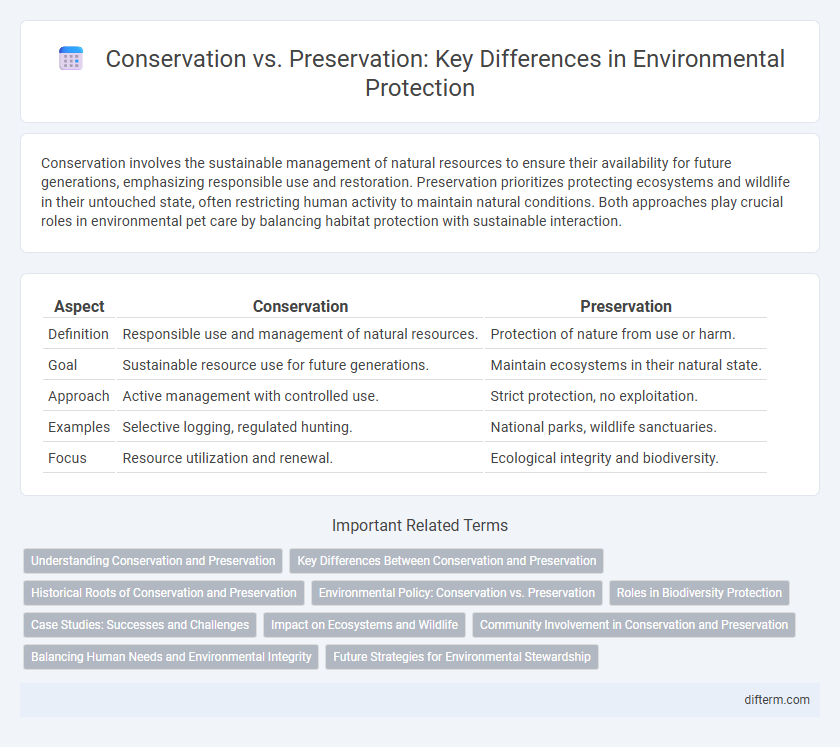Conservation involves the sustainable management of natural resources to ensure their availability for future generations, emphasizing responsible use and restoration. Preservation prioritizes protecting ecosystems and wildlife in their untouched state, often restricting human activity to maintain natural conditions. Both approaches play crucial roles in environmental pet care by balancing habitat protection with sustainable interaction.
Table of Comparison
| Aspect | Conservation | Preservation |
|---|---|---|
| Definition | Responsible use and management of natural resources. | Protection of nature from use or harm. |
| Goal | Sustainable resource use for future generations. | Maintain ecosystems in their natural state. |
| Approach | Active management with controlled use. | Strict protection, no exploitation. |
| Examples | Selective logging, regulated hunting. | National parks, wildlife sanctuaries. |
| Focus | Resource utilization and renewal. | Ecological integrity and biodiversity. |
Understanding Conservation and Preservation
Conservation involves the sustainable use and management of natural resources to prevent depletion, emphasizing human interaction and responsible stewardship. Preservation prioritizes protecting ecosystems and wildlife in their natural state, minimizing human impact to maintain biodiversity and ecological integrity. Understanding the distinction between conservation and preservation is crucial for developing effective environmental policies that balance resource use with ecosystem protection.
Key Differences Between Conservation and Preservation
Conservation emphasizes the sustainable use and management of natural resources to meet current and future human needs while maintaining ecosystem health. Preservation advocates for protecting nature from any human interference, keeping habitats and wildlife intact in their original state. Understanding these key differences is crucial for developing effective environmental policies that balance human activity with ecological integrity.
Historical Roots of Conservation and Preservation
Conservation and preservation both stem from 19th-century environmental movements but diverge in focus; conservation, championed by Gifford Pinchot, advocates for the sustainable use of natural resources, while preservation, led by John Muir, emphasizes protecting nature from human interference. The historical roots of these approaches highlight conservation's pragmatic management ethos and preservation's intrinsic value of wilderness. These foundational philosophies continue to influence contemporary environmental policies and debates on resource management.
Environmental Policy: Conservation vs. Preservation
Environmental policy distinguishes conservation as the sustainable management and use of natural resources to prevent depletion, prioritizing resource availability for future generations. Preservation emphasizes the protection of ecosystems and biodiversity by limiting human intervention and maintaining areas in their natural state. Effective policies balance conservation's resource utilization with preservation's ecosystem integrity to ensure long-term environmental health.
Roles in Biodiversity Protection
Conservation focuses on the sustainable management and utilization of natural resources to maintain ecosystem health while enabling human use, actively promoting biodiversity through habitat restoration and controlled resource use. Preservation prioritizes protecting ecosystems and species from human interference by maintaining areas in their pristine states, safeguarding biodiversity by allowing natural processes to occur undisturbed. Both approaches play critical roles in biodiversity protection by balancing human needs with the intrinsic value of ecosystems, supporting the survival of diverse species and genetic variability.
Case Studies: Successes and Challenges
Case studies in environmental conservation highlight the success of community-led reforestation projects in restoring biodiversity and improving ecosystem services, while preservation efforts in protected areas have effectively maintained habitats for endangered species. Challenges remain in balancing human development needs with strict preservation policies, as seen in conflicts over land use in national parks. Adaptive management approaches that integrate scientific monitoring and local stakeholder involvement prove essential for achieving sustainable outcomes.
Impact on Ecosystems and Wildlife
Conservation emphasizes sustainable use and management of natural resources, allowing ecosystems and wildlife to thrive while supporting human needs, which often maintains biodiversity and ecological balance. Preservation advocates for protecting ecosystems by minimizing human interference, leading to intact habitats that support sensitive species but may restrict resource access for communities. Both approaches impact ecosystems and wildlife differently, with conservation promoting adaptive coexistence and preservation ensuring strict protection of natural environments.
Community Involvement in Conservation and Preservation
Community involvement plays a crucial role in successful conservation and preservation efforts by fostering local stewardship and ensuring sustainable resource management. Engaging residents through education, participatory decision-making, and collaborative projects enhances biodiversity protection and habitat restoration outcomes. Effective community participation strengthens resilience to environmental changes and promotes long-term ecological balance.
Balancing Human Needs and Environmental Integrity
Balancing human needs and environmental integrity requires integrating sustainable resource management practices that promote conservation by allowing renewable resource use without depletion. Preservation emphasizes protecting ecosystems in their natural state, limiting human intervention to maintain biodiversity and ecological processes. Effective environmental strategies blend conservation and preservation principles to support economic development while safeguarding habitat health and resilience.
Future Strategies for Environmental Stewardship
Future strategies for environmental stewardship emphasize adaptive management that balances conservation and preservation to sustain biodiversity. Integrating technology-driven monitoring tools enhances habitat protection while promoting sustainable resource use. Collaborative efforts between governments, communities, and scientists are crucial for implementing scalable solutions that mitigate climate change impacts and conserve natural ecosystems.
conservation vs preservation Infographic

 difterm.com
difterm.com